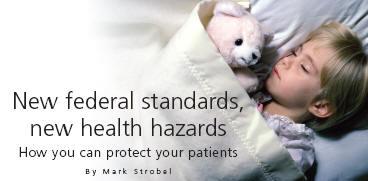
Reprinted from Chiropractic Economics magazine March 30, 2007, page 52

New federal standards, new health hazards -- How you can protect your patients, By Mark Strobel
A relatively new federal regulation (16 CFR 1640) that has good intent — but potentially harmful results — has created an opportunity for you to safeguard the overall health of your patients, as well as the chance for economic gain.
The regulation is the national flammability
standard for mattresses, approved by the U.S. Consumer Product Safety Commission
(CPSC) in February 2006. The new national flameproof mattress standard requires
all new mattresses to withstand a two-foot wide blowtorch open-flame test for 70
seconds.
Although the intent of the standard is admirable and will save lives, it poses a
significant health hazard to consumers:
• Hazardous chemicals. Most mattresses that pass the severe open-flame
test have been treated with toxic and cancer-causing chemicals. Manufacturers
are not required to label the chemicals they use; they are also free to use any
untested chemicals they wish. The most frequently used chemicals in fire
proofing, however, are boric acid (roach killer), antimony (a heavy metal almost
identical to arsenic, a known carcinogen), and decabromodiphenyl oxide (DBDPO, a
carcinogen).
• Leaching. The chemicals used for fire prevention can leach to the
surface of flameproof mattresses and be absorbed by the body.
The CPSC measured the amount of toxic chemicals that leach to the surface of
flameproof mattress. It assumed that the human body will daily absorb only
1/10,000 of the boric acid (.081 milligrams), 1/1,000 of the DBDPO (.073
milligrams), and 2/1,000 of the antimony trioxide (.802 milligrams). If their
absorption assumptions are wrong, sleepers might absorb much more than the CPSC
predicts.
• No labeling requirements. The standard does not mandate labeling of the
chemicals used in fireproofing.
Continued after side bars:
Faulty review process?
The CPSC passed the fireproofing
standard, despite the recommendations of an independent review of the studies
performed on mattresses.
The independent review complained strongly that the CPSC’s assumptions for safe
levels of toxin absorption do not agree with assumptions made by other agencies.
For example: The Environmental Protection Agency (EPA) approves a much lower
level of antimony absorption.
Additionally, the report excluded children younger than age five. The CPSC
assumed children younger than this age sleep on vinyl sheets because of the
possibility of bedwetting, and that the vinyl will protect them from absorbing
the toxic chemicals in their mattresses. However, studies by European scientists
prove antimony leaches through vinyl on crib mattresses.1
1 Jenkins R.O.; Craig P.J.; Goessler W.; Irgolic K.J., “Antimony leaching from cot mattresses and sudden infant death syndrome (SIDS),” Hum Exp Toxicol. 1998 Mar;17(3):138-9
A tale of two toxins
Boric acid is roach killer, a simple acute
poison known to produce reproductive injuries.1 According to the American
Association of Poison Control Centers, boric acid already poisons 6,463
Americans each year.
Antimony seems to be readily absorbed through the skin and is known to
accumulate in the body. Antimony is a heavy metal, almost identical to arsenic.
Antimony is an ancient poison. The material safety data sheet (MSDS) for
antimony reads: “Chronic Exposure: Prolonged or repeated exposure may damage the
liver and the heart muscle. … May cause heart to beat irregularly or stop.”
Antimony trioxide is also known to cause cancer.
1 U.S. Environmental Protection Agency, Toxicological Review of Boron and Compounds, June 2004.
WHAT YOU CAN DO
Mattresses manufactured after July 2007 must conform to the fireproofing
standard. However, the law allows physicians, including chiropractors, to
prescribe toxin-free mattresses for patients.
If you agree the risk of fireproofed mattresses outweighs the benefits for your
patients, you can offer them a solution — prescription mattresses.
• Offer toxin-free chiropractic mattresses
to patients. A prescription mattress is appropriate for anyone. Many people
don’t want themselves or their children to absorb poison every night to avoid
the small risk of a mattress fire.
You can become a distributor of toxin-free (prescription) mattresses.
Manufacturers will ship the mattresses you prescribe directly to your patients.
To market this product, you can display a crib-sized mattress or a daybed (which
can double as a couch in your waiting room).
Your patients will benefit from toxin-free mattresses and you will benefit from
the profits on each mattress sale.
• Make the health risk known. You can advertise the health risk and solution with in-office displays, an exterior sign, and through media. Advertising toxin-free mattresses will bring new people to your office and result in additional patients.
Mark Strobel is president of Strobel Technologies, a specialty mattress manufacturer. He can be contacted at 800-457-6442, by e-mail at mark@strobel.com, or through his Web site, www.PrescriptionBeds.com.